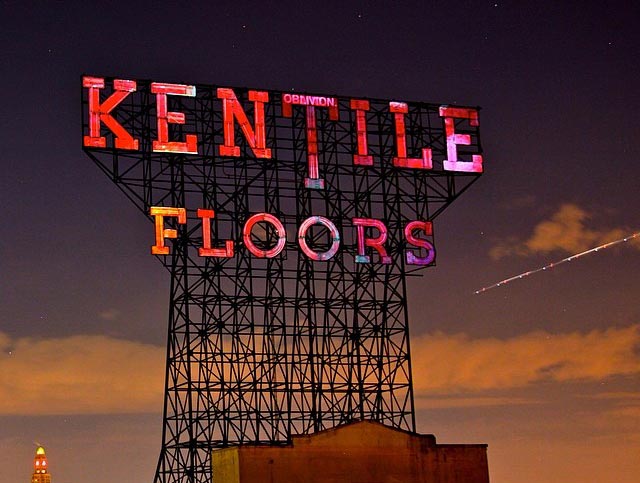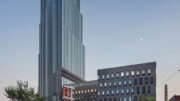On Thursday it was announced that the Kentile Floors sign, which had been threatened with demolition after towering above the warehouses and factories of Brooklyn’s Gowanus neighborhood for sixty years, would be saved from destruction.
City Councilman Brad Lander made an agreement with the sign’s owner to preserve its distinctive red letters during removal, so that they may be reinstalled at a nearby location in the future.
Although the Kentile sign is greatly admired, one thing its defenders may not realize is that a similar sign couldn’t be built today under the city’s zoning code. It is too large and too tall to be permitted without requesting a complicated zoning variance.
When the Kentile sign was built around 1949 the zoning code placed no restrictions on the construction of signs other than the height limits that applied to the building as a whole. It wasn’t until 2001 that the size and height of signs in manufacturing districts was regulated by law.
The Kentile sign, at about 4,200 square feet, is three and a half times larger than the maximum surface allowed in a manufacturing district. And at 88 feet, it is taller than the 75 feet allowed by zoning.
The amendments in 2001 sought to limit neighborhood-wrecking billboards. At the time, a planning department representative, in his testimony to the City Council, talked of “huge signs… reflecting garish light into residential units.” He was talking of billboards, not necessarily aesthetic masterpieces like the Kentile Floors sign.
It is indisputably handsome. With bold red letters 20 feet high, suspended 140 feet in the air, it reaches up to greet passengers on the F and G trains as they round the bend of the Culver Viaduct. It’s easy to see how commuters formed an emotional bond with the sign, as it welcomes them home from a long day’s work.

TF Cornerstone incorporated the old Pepsi Cola sign into its new East Coast Long Island City development; image via TFC
If precedence tells us anything, a future large-scale residential development on the Gowanus canal will feature the Kentile Floors sign: the Pepsi-Cola sign on the Long Island City waterfront and the Domino Sugar sign were both incorporated into new developments at the request of preservationists.
This hypothetical developer would have to work with the zoning department to create a special zoning district that would allow this type of sign to be installed. This is what happened at the Jet Blue building in Long Island City, where a special district permitted the construction of a sign for the airline with letters up to 25 feet high.
In 1949 the Kentile sign was built as of right, and no special permitting was required. Perhaps the city is better off now that it is protected from new, potentially garish signs — but maybe New York is losing out on something. Restricting flashing signs makes sense, but most New Yorkers find delight in old signs, even though their initial reception may be lukewarm.
Today the Kentile sign has become a symbol of the neighborhood’s rapidly fading industrial past. The reaction against its removal reveals the deep ambivalence and anxiety that residents feel about the neighborhood’s future. Some love the sign solely for its aesthetic beauty. Others have romantic ideas about the city’s industrial past that, for all its heroic qualities, also left behind the toxic sludge that makes the Gowanus Canal hazardous to human health.
But for many, passions are stirred by an aversion to change. In turn this has led to more restrictive zoning regulations—regulations like the one that prevents building owners from putting up signs like Kentile. These are what we call unintended consequences.
For any questions, comments, or feedback, email newyorkyimby@gmail.com
Subscribe to YIMBY’s daily e-mail
Follow YIMBYgram for real-time photo updates
Like YIMBY on Facebook
Follow YIMBY’s Twitter for the latest in YIMBYnews





